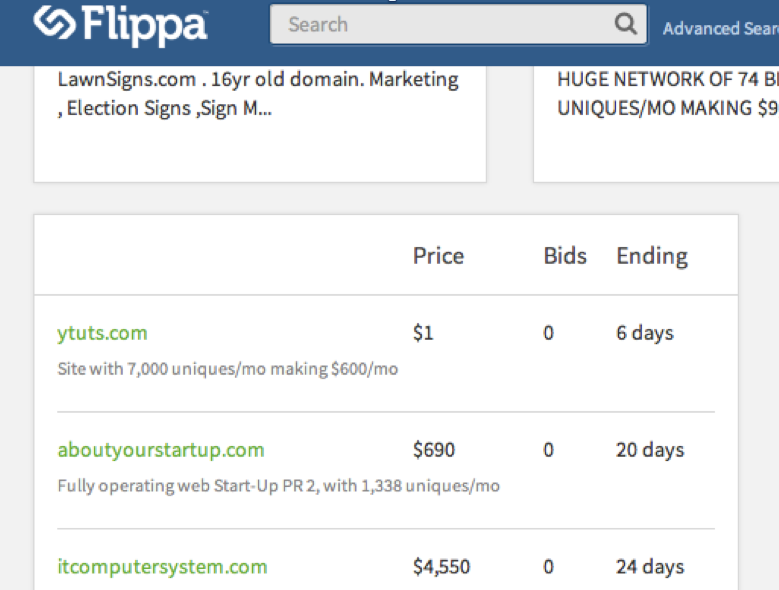
There’s certainly a healthy market for buying and selling websites to make a profit and the upside is that you don’t have to be a Larry Page to do it! The name of the game is just like many other investments. Think of it as a short-term or long-term real estate flip: look for quality websites that with a little tweaking will increase in value.
Buying an undervalued site will not just make money on its own. Many investors are deceived by the notion that buying a site for cheap will win them an instant profit just by sitting tight and selling it at a later time. They couldn’t be more wrong. Two things are true with this philosophy. Either you will make a quick, but relatively small profit or take a loss. Neither is an attractive outcome so you must really consider the risks. The most important question to ask yourself is, do you have what it takes to grow the site to its full potential?
I use the analogy of flipping houses. A real estate investor looking to make a quick profit, knows that along with due diligence, he or she needs a team to pull it off. You wouldn’t buy a house and expect to replace carpet, re-tile, and renovate a kitchen all on your own, especially while managing your day job. The same is true for buying and selling websites. While websites are relatively passive, transitioning from a ho-hum site to a full blown revenue stream will require some caressing in the form of SEO (Search Engine Optimization), content generation, and social media management, which can be a full time job in and of itself. If revamping websites is all you plan on doing, then it’s possible to go at it alone; however, most investors have their hands in a dozen, if not more, projects and can’t afford the time and they look at this revenue opportunity through the eyes of a project manager.
Again, I revisit the earlier question: Do you have what it takes to grow the site to its full potential?

I have explained the commitment and if you are still on board, we will press forward on how to actually buy and sell websites with these 10 steps:
1. Money and Time.
How much do you have to spend? Even the most attractive investments have risk. Know your limits. Can you afford to invest $5,000 and more importantly, could you risk losing that much? Do you have the time and resources to gain the knowledge and skill set required to successfully managing the new business?
2. Know what sites will grow.
You’ll need to know what sites have the most growth potential. Look for websites that have a niche or product that won’t dry up because the demand is always constant. Evergreen niches include car insurance, clothing, business, beauty, health, sports, consumer electronics, etc. Focus on things that don’t have an expiration date and stay clear of fads and things that could potentially be eliminated due to laws and regulations.
3. Buying an established site vs. non-established site.
There are many positive reasons for buying an established site, most importantly, an established site offers a history of performance for valuation. A history of performance will allow you to measure and forecast growth. If you know that the website has made money from search engines, you will be able to scale it based on the keywords it’s ranking for. Past revenue sources will be clearly defined, allowing you to turn a profit quicker by negotiating better affiliate payouts, optimizing ad placements, increasing sales conversions, etc. By buying an established site, you are not reinventing the wheel, just looking for a solid site that can be improved upon.
Don’t beat yourself up buying a site you have no interest in. With so many sites for sale that could be real winners, go for something that piques your interest.
4. Where to find websites for sale.
When on the search to buy websites, having reasonable expectations will help you when weeding through the inventory. A reasonable range when looking to buy a site is 12 to 18 times the monthly profit average for a moderately small site, which is valued around $50,000 or less. For example, a purchase price would range from $12,000 to $18,000 for a site generating $1,000 a month. If you can spot growth potential, you could pick up a real moneymaker, but it truly depends on the site and the seller and doing your homework. Some of the most popular places to find websites for sale are:
- Website brokers (FlippingEnterprises.com, Wesellyoursite.com, etc.)
- Website marketplaces (Flippa.com, Bizbuysell.com, WebsiteBroker.com, etc.)
- Forum marketplaces (Experienced-People.net, Warriorforum.com “websites for sale” section, Digital Point forums, etc.)
- Directly from buyer (Google search and email contact or people you know)
Here’s a screen shot from Flippa.com

5. Conduct quick due diligence.
Being able to spot red flags by knowing what to look for will save you an enormous amount of time and work. More likely than not, as you work your way through the listings, you’ll find a lot of unworthy sites and will relinquish them to your “trash” filter. When you find a site that sparks your interest, ask yourself the following questions for a quick due diligence:
- Why are they selling it? Dying niches, borderline services and products are red flags that you’ll want to keep in mind.
- Can they provide revenue and traffic documentation? Google analytics is a trusted platform that will give proper insight to how much traffic the site has generated and look for evidence that the website URL comes from the claimed source.
- Can you trust the seller? We would all like to think we are good judges of character and can spot a shady deal, but to avoid any blunders, do a Google search on their name and look through at least four pages of results as well as looking at their account feedback and history.
6. Conduct thorough due diligence.
The site has made it through the initial due diligence and now you need to look deeper into specific details. Moving forward focus on these four digging details:
- Traffic analytics. Analyze any slow periods of traffic as well as peak traffic. What are the site’s main sources of traffic? Is there a wide range of sources or has it relied solely on one or two main sources? Check out the referring sites and note if the seller owns them. Be sure to ask if the links will remain in place after the sale.
- Revenue proof. One way to get revenue proof is to get the “URL channel” reports for Google Adsense.
- Speak to the seller. A lot can be determined by speaking to the seller on the phone, Facetime or Skyping with them. Establishing a rapport will reinforce your buying decision and better help with negotiations should you decide to make a purchase.
- Speak to a professional-At this point, you might want to bring in a third party to assist you with due diligence. Many brokers are willing to offer “buy-side” services.
7. Making the right offer.
If you are ready to make an offer, get the seller’s attention by making a reasonable offer, but start low so you can negotiate. A reasonable offer would be 70 percent of the asking price to jump start negotiations. If the site has some negative aspects, be prepared to state those as a bargaining tool and tell the seller that you will be able to improve upon those issues. Having cash upfront tells the seller that you are a serious buyer and you’ve been shopping the market. At the end of the day, they don’t want to loose a sale.
8. You’re the proud owner of a new site: Now what?
There’s no time to hit the snooze button after all your hard work and due diligence.
First, you will want to make sure the site is automated the best you can. Five hours a week for basic maintenance is far more desirable than 20 hours and will look more attractive when you decide to flip the site.
- Start building traffic and monetizing the website.
- Hire qualified and reputable help. Individuals that can help with SEO, customer service and sales reps are a dime a dozen––make sure you find someone charging the right fee and who can prove their skills and abilities.
9. Your site is rockin’, now you want to sell!
Congratulations, you have done what you set out to do! You’ve breathed new life into a website and now it’s in prime position to make you some real money. Ask yourself the following questions to determine if this is indeed the right time to sell:
- Have you exhausted all possible ways to optimize traffic and earnings? You might have taken the site to where it is even though there’s more work ahead, but that doesn’t mean it’s not the perfect time for you to sell. Now you have opened up a market to potential buyers who can buy your site and expand on it further.
- What percentage of your investment has already been returned? If you sell now, will you make a positive return on your investment?
10. How to sell your site.
The tables have turned and now you will be the seller. Expect potential buyers to go through the same steps you did and be prepared to offer up as much information as possible to make an attractive deal. Revisit the same places we explored in Step 3:
- Website brokers (FlippingEnterprises.com, Wesellyoursite.com, etc.)
- Website marketplaces (Flippa.com, Bizbuysell.com, WebsiteBroker.com, etc.)
- Forum marketplaces (Experienced-People.net, Warriorforum.com “websites for sale” section, Digital Point forums, etc.)
- Directly from buyer (Google search and email contact or people you know)
Keep in mind these four points:
- Be prepared to sell — Keep detailed records of traffic and income.
- Be upfront and honest — Create trust and integrity with potential buyers during their due diligence period.
- Don’t be greedy — You don’t want to out price yourself same as a home owner wouldn’t want to price their home too high as you could run the risk of getting passed over. Flippa is a good site to help you determine asking price.
- Enlist a broker service — A professional can give you a valuation and advice as well as list your site for you.
What happens after you find a buyer and your flipped site is sold?
Do it all over again! Get ready to sink your teeth into another deal. Put into practice all the systems that worked for you the last go around and plan to make improvements where needed.
The post 10 Steps to Making a Profit Buying and Selling Websites appeared first on Blogtrepreneur - The Business of Blogging For Busy Entrepreneurs.